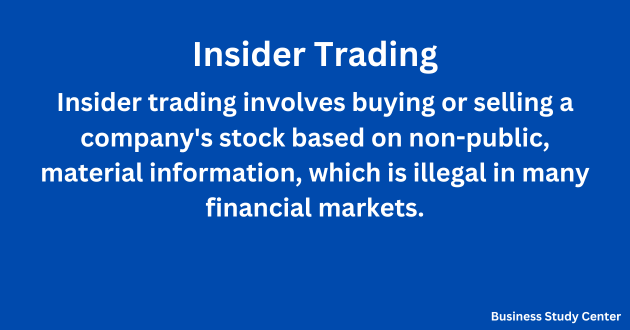
Introduction
Insider trading is a topic that has garnered significant attention and controversy in the financial world. It involves the buying or selling of a publicly-traded company’s securities based on material non-public information. This practice is widely considered unethical and illegal in most jurisdictions. In this comprehensive guide, we will delve into the intricacies of insider trading, including its definition, examples, and the penalties associated with it.
Defining Insider Trading
1. Material Information
Insider trading involves the trading of securities based on material non-public information. Material information is defined as any information that could potentially have a significant impact on an investor’s decision to buy or sell a security. For example, advance knowledge of a company’s upcoming earnings report or the results of a drug trial would be considered material information.
2. Non-Public Information
Non-public information refers to information that is not yet available to the general public. It is information that is known only to a select few individuals who have direct access to it. These individuals may include corporate executives, government officials, or other individuals with insider knowledge.
3. Variations in Definitions
The definition of an “insider” can vary from jurisdiction to jurisdiction. Some jurisdictions have a narrow definition, considering only individuals within the company who have direct access to the information as insiders. In contrast, other jurisdictions may have a broader definition, encompassing individuals who are related to company officials or have access to the information through indirect means.
Hypothetical Examples of Insider Trading
Insider trading can take various forms based on the specific circumstances and individuals involved. Here are a few hypothetical examples to illustrate different scenarios:
- CEO Disclosure: The CEO of a company shares confidential information about an imminent acquisition with a friend who owns a significant portion of the company’s stock. The friend acts upon this information and sells their shares before the news becomes public.
- Government Employee: A government employee learns about a forthcoming regulation that will benefit a specific company. Using this insider knowledge, the employee purchases shares of the company before the regulation is made public.
- High-Level Employee: An employee overhears conversations about a potential merger and recognizes the potential market impact. They subsequently buy shares of the company in their father’s account based on this non-public information.
Real-life Examples of Insider Trading
While hypothetical scenarios help illustrate the concept, real-life examples provide a more tangible understanding of the consequences of insider trading. Here are some notable cases:
1. Martha Stewart
Martha Stewart, a well-known entrepreneur and television personality, was involved in an insider trading case related to ImClone Systems. Stewart sold her shares in ImClone after receiving advance notice that the FDA had rejected the company’s new cancer drug. Stewart’s actions led to her resignation as CEO of her company, and she was ultimately convicted of insider trading.
1. Reliance Industries
In India, the Securities and Exchange Board of India (SEBI) imposed penalties on Reliance Industries for violating regulations on derivatives trading. The company was accused of manipulating its stock price in the cash market and exceeding its legally permissible trading limits. The SEBI banned Reliance Industries from the derivatives sector for a year and imposed a fine.
2. Joseph Nacchio
Joseph Nacchio, the former CEO of Qwest Communications, was convicted of insider trading for selling his stock while misleading shareholders about the financial state of the company. Nacchio profited from the sale of his shares, despite knowing about the severe problems facing Qwest Communications. He was found guilty and faced significant penalties.
3. Yoshiaki Murakami
Yoshiaki Murakami, a prominent Japanese fund manager, was involved in an insider trading case related to Livedoor, a financial services company. Murakami used non-public material information about Livedoor’s plans to acquire a stake in Nippon Broadcasting to make substantial profits. He was found guilty of insider trading.
4. Raj Rajaratnam
Raj Rajaratnam, a billionaire hedge fund manager, was involved in one of the most high-profile insider trading cases in recent history. Rajaratnam was charged with swapping tips with other traders, hedge fund managers, and key employees of prominent companies like IBM, Intel Corp, and McKinsey & Co. He was found guilty and faced significant fines.
Penalties for Insider Trading
Insider trading is a serious offense that carries severe penalties. The specific penalties vary by jurisdiction, but they typically include fines and imprisonment. For instance, in the United States, a conviction for insider trading can result in a maximum fine of $5 million and up to 20 years of imprisonment. In India, the SEBI can impose penalties of up to INR 250,000,000 or three times the profit made from the illicit trading, whichever is higher.
Building Trust in the Financial System
Prosecuting insider trading cases is crucial for maintaining trust in the financial system. By holding individuals accountable for their actions, regulators and law enforcement agencies ensure a level playing field for all investors. These cases serve as a deterrent to potential wrongdoers and emphasize the importance of fair and transparent markets.
In conclusion, insider trading is a practice that involves trading securities based on material non-public information. It is considered unethical and illegal in most jurisdictions due to its potential to undermine market fairness and investor trust. Real-life examples highlight the serious consequences individuals face when engaging in insider trading. By enforcing strict penalties, regulators aim to deter insider trading and maintain confidence in the financial system.


